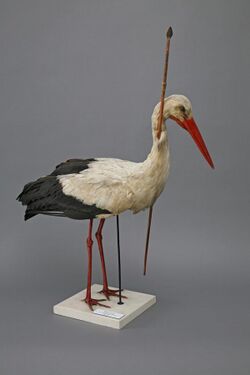Biology:Pfeilstorch

Pfeilstorch for 'arrow stork', pronounced [ˈpfaɪ̯l.ˌʃtɔɐ̯ç]; plural Pfeilstörche, [-ˌʃtœɐ̯.çə]) is a stork that gets injured by an arrow while wintering in Africa and returns to Europe with the arrow stuck in its body. As of 2003, about 25 Pfeilstörche have been documented in Germany.[1]
The first and most famous Pfeilstorch was a white stork found in 1822 near the German village of Klütz, in the state of Mecklenburg-Vorpommern. It was carrying a 75-centimetre (30 in) spear from central Africa in its neck.[2][3] The specimen was stuffed and can be seen today in the zoological collection of the University of Rostock. It is therefore referred to as the Rostocker Pfeilstorch.[4][5][6]
This Pfeilstorch was crucial in understanding the migration of European birds. Before migration was understood, people struggled to explain the sudden annual disappearance of birds like the white stork and barn swallow. Besides migration, some theories of the time held that they turned into other kinds of birds, mice, or hibernated underwater during the winter, and such theories were even propagated by zoologists of the time.[7][8][9] The Rostocker Pfeilstorch in particular proved that birds migrate long distances to wintering grounds.[10]
References
- ↑ "Der Rostocker Pfeilstorch". Der Sprössling. University of Rostock. 2003. pp. 9–10. http://www.biofachschaft.uni-rostock.de/fileadmin/MathNat_Bio_Fachschaft/Sproessling_Nr._3_SS03.pdf. "Mittlerweile sind etwa 25 Fälle bekannt geworden, in denen Weißstörche ganze Pfeile oder Bruchstücke aus Afrika nach Deutschland mitbrachten."
- ↑ Fone, Martin (11 January 2020). "Curious Questions: How did a stork with a spear through its neck solve the mystery of the migration of birds?". https://www.countrylife.co.uk/nature/curious-questions-stork-spear-neck-solve-mystery-migration-birds-210144.
- ↑ Baykal, Hakan (20 May 2022). "Vogelzug: Die wahre Geschichte vom Pfeilstorch". spektrum.de. https://www.spektrum.de/news/vogelzug-die-wahre-geschichte-vom-pfeilstorch/2019937.
- ↑ "Zoologische Sammlung der Universität Rostock" (in de). http://www.zoologie.uni-rostock.de/sammlung/.
- ↑ "Flyer for the Rostock University Zoological Collection" (in en). http://www.zoologie.uni-rostock.de/fileadmin/MathNat_Bio_Zoologie/ZSRO_Flyer_2007_Engl.pdf.
- ↑ "Der Sproessling 3" (in de). http://www.biofachschaft.uni-rostock.de/fileadmin/MathNat_Bio_Fachschaft/Sproessling_Nr._3_SS03.pdf.
- ↑ Cocker, Mark; Mabey, Richard (2005). Birds Britannica. Chatto & Windus. p. 315. ISBN 0-7011-6907-9.
- ↑ Pomeroy, Ross (February 19, 2018). "The Weirdest Ideas About Bird Migration". https://www.realclearscience.com/blog/2018/02/19/the_weirdest_ideas_about_bird_migration.html.
- ↑ MacDonald, Helen (2015-05-15). "Flight Paths". The New York Times. https://www.nytimes.com/2015/05/17/magazine/flight-paths.html.
- ↑ Kinzelbach, Ragnar K. (2005) (in de). Das Buch vom Pfeilstorch. Basilisken-Presse. ISBN 3-925347-78-X.
Further reading
- Hagen, H. (1975). "Beobachtung eines Pfeilstorches in Ost-Afrika" (in de). Ornithologische Mitteilungen 27 (5): 111–112.
 |

